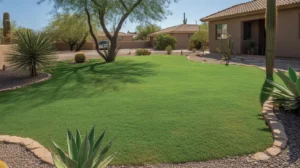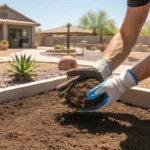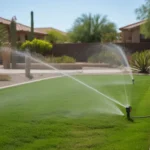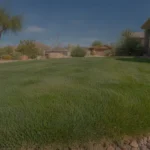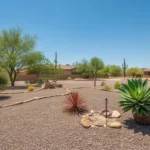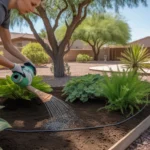As the weather warms and days grow longer, spring is the perfect time to give your Southeast Valley yard some TLC. With the right care, you can help your lawn bounce back from winter dormancy and set the stage for a lush, resilient yard all season long. These spring yard care tips will have your grass looking its best, from Mesa to Queen Creek and all around the Southeast Valley.
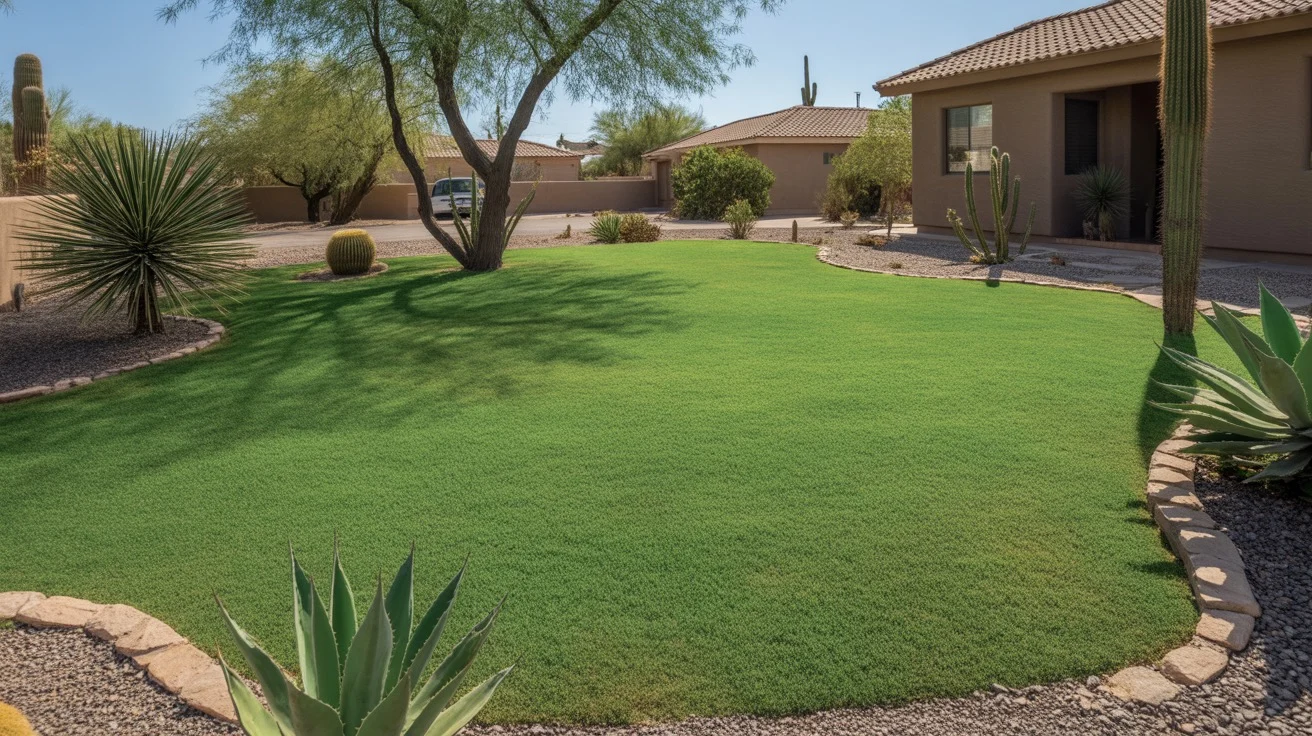
Wake Up Your Lawn with Smart Watering
One of the first steps in spring yard care is adjusting your watering schedule. As temperatures rise, your grass will start to grow more actively and require more moisture. However, it’s important not to overwater, as this can lead to shallow roots and fungal growth.
Aim to water deeply and infrequently, allowing the top inch of soil to dry out between watering. For most Southeast Valley lawns, this means watering 2-3 times per week in spring. Water in the early morning hours to minimize evaporation and give the grass time to dry before nightfall. If you’re not sure if your lawn needs water, try the screwdriver test – if you can easily push a screwdriver 6 inches into the soil, it’s sufficiently moist.
Keep in mind that different grass types have different watering needs. Bermuda and zoysia grasses are drought-tolerant and can handle some dryness, while ryegrass and fescue prefer more regular moisture. Adjust your sprinkler settings accordingly and keep an eye out for signs of water stress like wilting or grayish grass.
Feed Your Lawn for Peak Performance
Spring is also the time to start fertilizing your Southeast Valley lawn. After a winter of dormancy, your grass is hungry for nutrients to fuel new growth. However, timing is key when it comes to feeding your lawn.
Wait until your grass is actively growing before applying fertilizer – usually late March or early April for warm-season grasses like Bermuda and zoysia. Use a balanced, slow-release fertilizer with equal parts nitrogen, phosphorus and potassium. This will provide a steady supply of nutrients over 6-8 weeks.
Avoid over-fertilizing, as this can lead to excessive growth, thatch buildup and even fertilizer burn. A good rule of thumb is to apply no more than 1 pound of nitrogen per 1000 square feet. Always follow package instructions and water in fertilizer thoroughly to avoid scorching your grass.
Mow High for Healthier Grass
Once your grass starts growing steadily, it’s time to break out the mower. But don’t go too short! Scalping your lawn can stress the grass and expose soil to weeds. Instead, set your mower height to remove no more than 1/3 of the grass blade at a time.
Ideal mowing heights vary by grass type, but most Southeast Valley lawns do well at 1-1.5 inches in spring. Taller grass has deeper roots, retains moisture better, and is more resilient to foot traffic and heat stress. Mow weekly or as needed to maintain your target height.
Always mow with sharp blades to avoid tearing the grass. Leave the clippings on the lawn as you mow – they’ll quickly decompose and return nutrients to the soil. If you have excessive clippings, rake and remove them to prevent smothering the grass underneath.
Tackle Weeds Before They Take Over
Spring is prime time for weed seeds to sprout in your lawn. Catching them early is key to preventing a full-blown invasion. Start with good cultural practices like proper watering, mowing and fertilizing to promote thick, healthy grass that can outcompete weeds.
For existing broadleaf weeds like dandelions, clover and spurge, spot-treat with a selective post-emergent herbicide. Look for products containing 2,4-D, dicamba or triclopyr, and follow all label instructions. Avoid spraying on windy days or near desirable plants.
For grassy weeds like crabgrass and foxtail, apply a pre-emergent herbicide in early spring before soil temperatures reach 55°F. This will prevent weed seeds from germinating. Timing is critical, so watch the weather and apply when forsythia bushes bloom or around mid-February in the Southeast Valley.
Aerate and Dethatch for Thicker, Greener Grass
Over time, soil can become compacted, preventing air, water and nutrients from reaching the grass roots. This is especially common in high-traffic areas or clay-heavy soils in the Southeast Valley. Aerating your lawn in spring helps alleviate compaction and promote root growth.
Use a core aerator to remove small plugs of soil from the lawn. Leave the plugs on the grass to decompose – they’ll help improve soil structure over time. Aim to aerate warm-season lawns in late spring or early summer when they’re actively growing. Cool-season grasses like ryegrass and fescue are best aerated in early spring or fall.
Spring is also a good time to dethatch your lawn if needed. Thatch is the layer of dead grass stems and roots between the soil and living grass blades. A thin layer is beneficial, but more than 1/2 inch of thatch can harbor pests and disease and prevent water from penetrating the soil.
Use a dethatching rake or rent a power dethatcher to remove excess buildup. Dethatch warm-season grasses in late spring or early summer, and cool-season grasses in early spring or fall. Always dethatch before aerating to avoid clogging the aerator tines.
Overseed for a Lush, Resilient Lawn
If your Southeast Valley lawn is looking thin or patchy, spring is a good time to overseed with fresh grass seed. Overseeding helps fill in bare spots, thicken the turf, and improve your lawn’s overall appearance and resilience.
For warm-season grasses like Bermuda and zoysia, overseed in late spring or early summer when soil temperatures are consistently above 65°F. Use a drop spreader for even coverage, and aim for 2-4 pounds of seed per 1000 square feet, depending on the extent of thinning.
For cool-season grasses like ryegrass and fescue, the best time to overseed is in fall when soil temperatures drop below 75°F. However, if your lawn has significant damage from winter, you can do a light spring overseeding to help it recover. Use 1-2 pounds of seed per 1000 square feet, and keep the soil consistently moist until the seedlings are established.
After overseeding, avoid heavy foot traffic on the area and keep the soil moist with light, frequent watering. Mow the new grass once it reaches your normal mowing height, but avoid applying herbicides for at least 6 weeks to prevent damaging the seedlings.
Troubleshooting Common Spring Lawn Issues
Even with the best spring yard care, issues can still pop up. Here are some common problems Southeast Valley homeowners face and how to fix them:
- Yellow or brown patches: This could be a sign of nutrient deficiency, uneven watering, disease, or pest damage. Test your soil to check nutrient levels, adjust your watering schedule, and look for signs of fungus or insects. Apply fertilizer or treat with fungicide or insecticide as needed.
- Mushrooms in the lawn: Mushrooms often sprout in spring when the soil is moist and shady. While unsightly, they’re generally harmless and will disappear on their own. To prevent them, reduce watering, improve drainage, and trim trees to allow more sunlight to reach the lawn.
- Thin or patchy grass: Bare spots can be caused by heavy foot traffic, pet damage, improper mowing, or poor soil conditions. Overseed the area, aerate to reduce compaction, and adjust your mowing and watering practices. If the problem persists, you may need to replace the grass in that area.
- Grubs in the soil: Grubs are the larvae of beetles that feed on grass roots, causing brown patches and wilting. Check for grubs by cutting a small square of turf and inspecting the soil. If you find more than 5 grubs per square foot, treat with a grub-specific insecticide or beneficial nematodes.
By staying vigilant and addressing issues promptly, you can keep your Southeast Valley lawn looking its best all spring and summer long. With a little know-how and elbow grease, you’ll be rewarded with a yard that’s the envy of the neighborhood.

